
Bibliography
![]() Read more:
Read more:
Ocean Magnetic Survey Expeditions ![]()
Sailing the Magnetic Fields
Carnegie, a seagoing observatory, plotted the forces that send compasses awry
by John Bunker
[This article originally appeared in the November 1982 issue of Surveyor and is reprinted here with permission of the American Bureau of Shipping]
Until the widespread adoption of the gyro compass, the effect of the earth's magnetic field on a compass often led to major navigation errors, unnecessary course deviations, and misplotting of land features. Today, scientists are still trying to understand the reason for the earth's magnetic field, although the field's influences are known and have been plotted. Much of this current knowledge is owed to the early twentieth century research voyages of Carnegie, a unique pioneering ship specifically designed and specially built to be immune to the earth's magnetism.
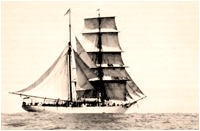 For
twenty years the non-magnetic, wooden-hulled Carnegie sailed
the oceans, including the iceberg-cluttered Arctic and Antarctic, carefully
locating and finely measuring then unknown magnetic influences. Today,
government organizations such as the National Oceanic and Atmospheric
Administration in the United States sponsor magnetic investigations based
on the original studies conducted by Carnegie from 1909 to 1929.
Officials at the Carnegie
Institution in Washington, D.C., one of the many scientific and educational
philanthropies established by Andrew Carnegie, the Pittsburgh steel tycoon,
built and operated the unusual ship to conduct scientific investigations
for the research organization's Department
of Terrestrial Magnetism.
For
twenty years the non-magnetic, wooden-hulled Carnegie sailed
the oceans, including the iceberg-cluttered Arctic and Antarctic, carefully
locating and finely measuring then unknown magnetic influences. Today,
government organizations such as the National Oceanic and Atmospheric
Administration in the United States sponsor magnetic investigations based
on the original studies conducted by Carnegie from 1909 to 1929.
Officials at the Carnegie
Institution in Washington, D.C., one of the many scientific and educational
philanthropies established by Andrew Carnegie, the Pittsburgh steel tycoon,
built and operated the unusual ship to conduct scientific investigations
for the research organization's Department
of Terrestrial Magnetism.
Carnegie's voyages were part of the Institution's program that included an ambitious magnetic, electric, and oceanographic survey of the oceans, coupled with magnetic and electric surveys of land areas in many parts of the world. The Institution maintained magnetic and electrical observatories at Watheroo in western Australia and at Huancayo in Peru to record continuously the variations in the magnetism, atmospheric electricity, and other electric currents of the earth.
Henry J. Gielow, a New York naval architect, designed Carnegie to be free of an ordinary ship's magnetism so that scientists aboard working with pioneer magnetometers could make accurate plottings of magnetic fields without interference. Faced with this challenge, Mr. Gielow and the ship's builder, Tebo Yacht Yard in Brooklyn, New York, produced a sleek vessel resembling a yacht with a graceful clipper bowsprit.
Overall, Carnegie measured one hundred fifty-five feet, six inches long, with a loaded waterline of one hundred twenty-eight feet, four inches, a thirty-three-foot beam and a twelve-foot, seven-inch draft, with a rating of three hundred and twenty-three deadweight tons, and a displacement of five hundred and sixty-eight tons. Rigged as a brigantine, Carnegie carried square sails on the foremast, and a fore-and-aft rig on the main for a total spread of twelve thousand, nine hundred square feet of canvas when all twelve sails were set.
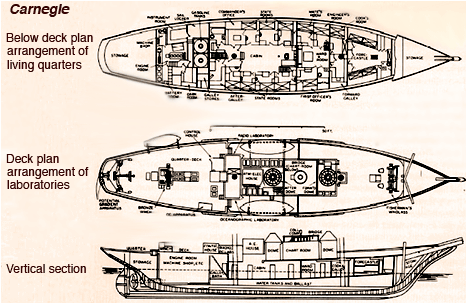
To meet the challenge of building a ship that would not affect the magnetometers, Tebo Yacht Yard installed white oak frames, planks and timbers. Locust treenails, and some bronze and copper bolts fastened the timbers. Hemp cables of eleven-inch circumference held the ship's four bronze anchors. Ship chandlers supplied Russian hemp hawser as a substitute for steel wire cable normally installed on a vessel this size. Manufacturers produced copper or bronze hull fittings, solid bronze bars for the bobstays on the bowsprit, phosphor-bronze wire for the headstays, and bronze blocks for the running gear.
The owners did not overlook the possibility of a potential magnetism problem originating in the galley equipment, which even today can be the bane of small boat sailors cruising with a magnetic compass. Owners stayed with iron grates for the two galley stoves, but they specified bronze for the remainder of the stove parts. Cooking utensils were copper and aluminum. So the knives, forks, and spoons did not disturb the instruments, officers and crew ate with elegant tableware made of Mexican silver.
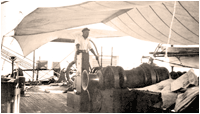 Carnegie's owners specified the ship carry auxiliary power to help the captain navigate narrow harbors, escape the doldrums, and evade ice
during voyages to the North and South Poles, where magnetic fields are strongest. To meet the non-magnetic specifications, engineers installed an
unusual four-cylinder, one-hundred-and-fifty horsepower "producer gas engine." Copper and bronze made up the body of the engine except for the cast
iron cylinder liners and steel cams for the valves and piston rods. This small amount of magnetic metal did not disturb the scientific instruments
aboard.
Carnegie's owners specified the ship carry auxiliary power to help the captain navigate narrow harbors, escape the doldrums, and evade ice
during voyages to the North and South Poles, where magnetic fields are strongest. To meet the non-magnetic specifications, engineers installed an
unusual four-cylinder, one-hundred-and-fifty horsepower "producer gas engine." Copper and bronze made up the body of the engine except for the cast
iron cylinder liners and steel cams for the valves and piston rods. This small amount of magnetic metal did not disturb the scientific instruments
aboard.
In specifying a producer gas engine the owners took a major gamble. There had been little maritime experience with this type of machinery, which converted coal to a gas by burning, then fed the vapor to the cylinders. The engine room consisted of a gas producer—a cylindrical furnace lined with asbestos and firebrick—and a four-cylinder marine internal combustion engine adapted for the coal gas by enlarging the inlet and exhaust valves, and increasing the compression ratio.
Owners selected the producer gas engine because they planned to operate Carnegie in areas of the world where gasoline would not be available, and designers believed such an engine would consume relatively small amounts of anthracite coal. The engine's performance showed the designers correct. Carnegie's engineers reported after the first voyage that the ship traveled one hundred and forty-five nautical miles at a cost of only seven dollars for coal.
At the launching ceremonies at Tebo's Brooklyn yard on 12 June 1909, Doctor Louis A. Bauer, director of the Terrestrial Magnetism Department, said that Carnegie's mission would be "to increase our knowledge of the constitution of the earth's magnetic field and to learn more of the amount of variations of the electricity in the atmosphere surrounding the earth."
He noted that magnetic forces in most of the world change constantly, even though the change may be very gradual and may not be recorded on charts. In 1580, for example, a compass in London pointed eleven degrees east, but by 1658 the needle had shifted to due north, and by 1812 pointed to twenty-four degrees west of true north. "In the interval of about two hundred and thirty-two years, compass direction there changed thirty-five degrees," Doctor Bauer said.
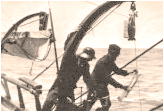 To determine the numerous variations that affect a magnetic compass, Carnegie carried equipment such as Nansen bottles (above, left) to measure water temperature, and a "collimating compass" (below) equipped with a telescope to measure the angle formed between a magnetic needle and the geographic meridian. The information gained helped create lines on a chart to show the angle the compass makes with true north and the south line wherever a ship is likely to go. To determine the numerous variations that affect a magnetic compass, Carnegie carried equipment such as Nansen bottles (above, left) to measure water temperature, and a "collimating compass" (below) equipped with a telescope to measure the angle formed between a magnetic needle and the geographic meridian. The information gained helped create lines on a chart to show the angle the compass makes with true north and the south line wherever a ship is likely to go.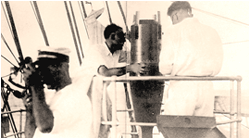 |
On her maiden voyage, Carnegie went through a severe "dusting" in the stormy North Atlantic, riding through a series of heavy winds that thoroughly tested hull and rigging and verified the ship seaworthy. On the initial cruise, scientists discovered an error of one degree in compass variation on charts of the North Atlantic then in use. This finding may seem insignificant, but to a navigator on a compass course, this deviation would take the vessel ten to twenty miles off the planned route.
Carnegie made seven long cruises, sailing all of the oceans between eighty degrees north latitude above the Arctic Circle and sixty-one degrees south latitude near Antarctica. On the ship's last four cruises, Carnegie was commanded by Captain James P. Ault, a member of the institution's Department of Terrestrial Magnetism who had studied physics at Columbia University in New York City.
Under Captain Ault's leadership, the trim square-rigger criss-crossed the seas in all types of weather. During the fourth cruise that began at New York in March, 1915, Carnegie covered seventy-three thousand miles and circumnavigated the globe through sub-[Ant]arctic regions. On this voyage and others, Carnegie many times escaped being crushed by icebergs. "Constant watchfulness and careful seamanship," said Captain Ault, "were required to prevent disaster."
On several occasions, collisions were avoided by less than a ship's length when huge bergs appeared suddenly from fog, mist, or driving snow. "It seemed," said Captain Ault, "like trying to sail down Broadway in New York City with all the skyscrapers gone wild and drifting around in our pathway." Thirty icebergs were sighted during one nerve-wracking day.
At one point in the Antarctic where the charts indicated an island, crew members did not see any land. Either the reported island had been an iceberg mistaken for land, or the action of the compass had misguided the discoverer into plotting the site incorrectly. On another voyage, scientists discovered magnetic declination had caused errors of twelve to sixteen degrees on charts of Indian Ocean waters off western Australia.
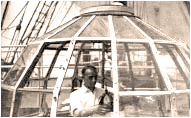 Carnegie scientists worked in circular observatories located fore and aft on the main deck. Each observatory was fitted with a revolving dome to permit sightings on celestial or terrestrial objects to determine the precise location of the ship and magnetic forces. |
From 1921 to 1927, Institution officials laid up Carnegie for extensive repairs, while they prepared a new program of oceanic investigations. Shipwrights installed new deck beams, planking and spars, and added thicker copper hull sheathing to afford the ship better protection against ice, and against shellfish that bore into timber. The latest scientific instruments were put in the top deck observation rooms, and in the laboratories. For the engine room crew, the most important change came when the owners decided to replace the old producer gas plant with a gasoline engine.
After a colorful send-off on 5 May 1928 from Washington, D.C., Carnegie's home port, the refurbished white-hulled craft sailed on her seventh cruise. On this voyage, scheduled to last three years, Carnegie circumnavigated the North Atlantic Ocean, passed through the Caribbean Sea, and transited the Panama Canal to cruise the southeast, central and north Pacific Ocean, touching at Easter Island, Peru, Tahiti, Guam, and Japan. The ship had sailed forty-three thousand miles, with about seventy thousand miles still to go, when the vessel stopped at Apia, Samoa, on 28 November 1929 for fuel and supplies.
The next day, while crewmen took on gasoline, an explosion occurred. The blast blew Captain Ault off the quarter-deck, and he died soon afterward. Cabin boy Tony Kelar, standing near him, landed in the harbor and was lost, and several crewmen were badly injured by flames. Within a few hours, Carnegie burned to the waterline.
Institution officials never replaced Carnegie. After considering the time necessary to design a new vessel, and a construction cost that would far exceed the original Carnegie, officials decided to redirect the Institution's magnetism studies to less expensive expeditions.
The non-magnetic brigantine Carnegie, a small ship for braving the seas in all types of weather, had logged an amazing record. From the time of launching in 1909 to the tragic fire twenty years later, Carnegie had traveled nearly three hundred thousand miles through the oceans of the world, a distance equivalent to more than one hundred crossings of the North Atlantic. Scientists aboard the ship had transmitted thousands of observations regularly to Washington for relay to hydrographic offices of maritime nations to aid cartographers in the correcting and updating of nautical charts. Carnegie had truly been a ship for the world.
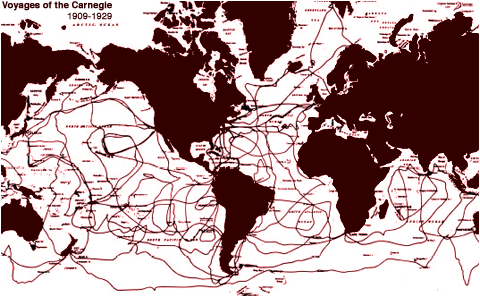
All rights reserved.
Exhibit was mounted on 07/19/2004.